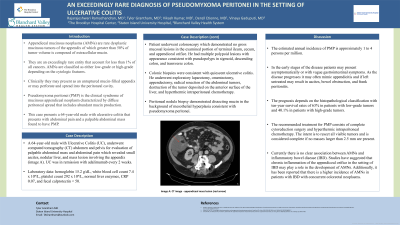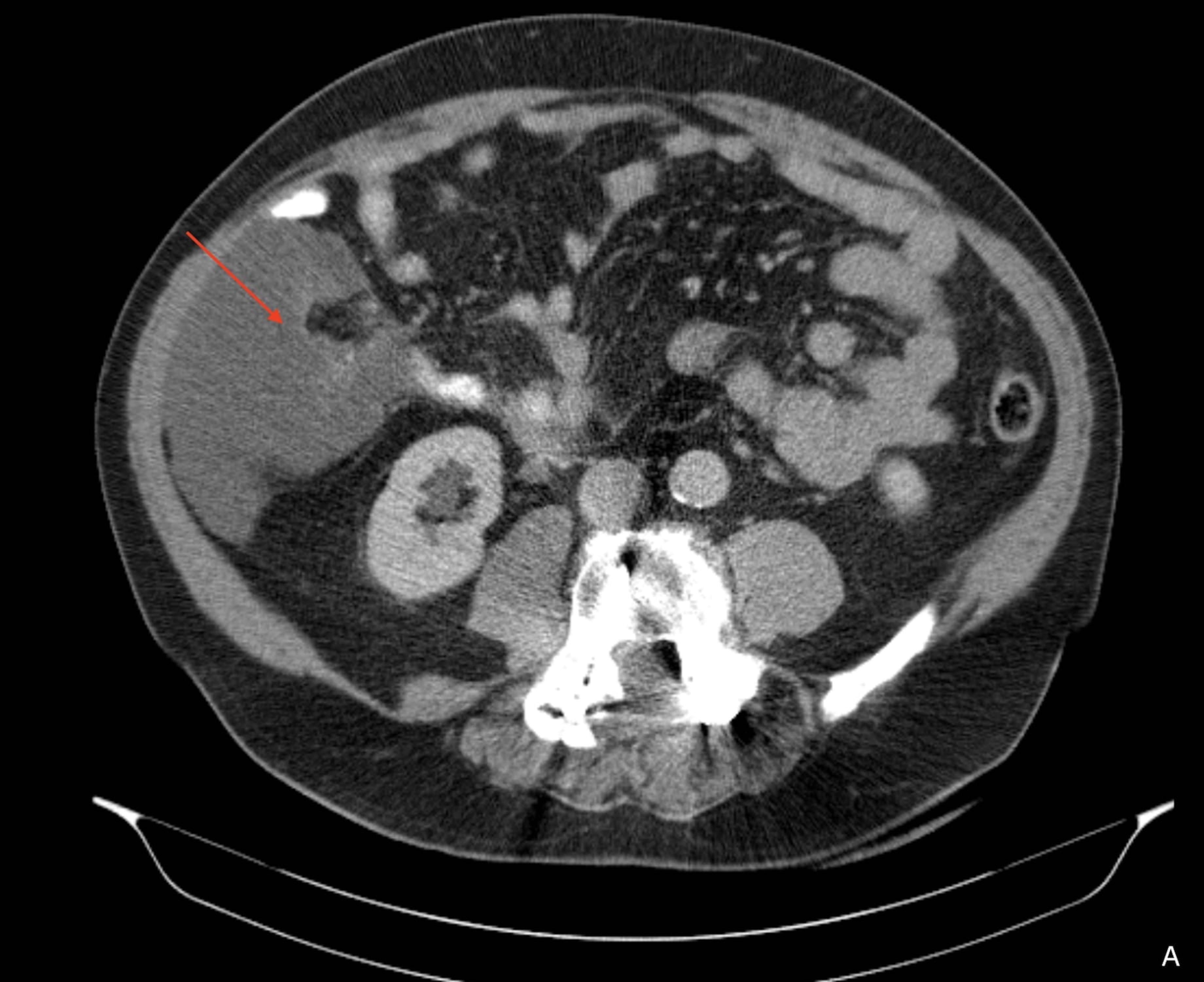Sunday Poster Session
Category: IBD
P0802 - An Exceedingly Rare Diagnosis of Pseudomyxoma peritonei in the Setting of Ulcerative Colitis
Sunday, October 22, 2023
3:30 PM - 7:00 PM PT
Location: Exhibit Hall

Has Audio
- TG
Tyler Grantham, MD
Staten Island University Hospital
Staten Island, NY
Presenting Author(s)
Rajarajeshwari Ramachandran, MD1, Tyler Grantham, MD2, Vikash Kumar, MD1, Denzil Etienne, MD1, Vinaya Gaduputi, MD3
1Brooklyn Hospital Center, Brooklyn, NY; 2Staten Island University Hospital, Staten Island, NY; 3Blanchard Valley Health System, Findlay, OH
Introduction: Appendiceal mucinous neoplasms are dysplastic mucinous tumors of the appendix and are an exceedingly rare entity that account for less than 1% of all cancers. They are classified into low or high grade depending on cytologic features. Pseudomyxoma peritonei is the clinical syndrome of mucinous appendiceal neoplasm with diffuse peritoneal spread. We present a 64-year-old man with ulcerative colitis (UC) who was diagnosed with pseudomyxoma peritonei when he presented with abdominal pain and palpable abdominal mass.
Case Description/Methods: A 64-year-old male with UC, underwent computed tomography (CT) abdomen and pelvis for evaluation of palpable abdominal mass and abdominal pain which revealed small ascites, nodular liver, and mass lesion involving the appendix (image A). UC was in remission with adalimumab every 2 weeks. Laboratory data: hemoglobin 15.2 g/dL, white blood cell count 7.4 x 10⁹/L, platelet count 292 x 10⁹/L, normal liver enzymes, CRP 0.07, and fecal calprotectin < 50. Following the identification of the possible appendiceal mass in the CT scan, the patient underwent colonoscopy which demonstrated no gross mucosal lesions in the examined portion of terminal ileum, cecum, and appendiceal orifice. He had multiple polypoid lesions with appearance consistent with pseudopolyps in sigmoid, descending colon, and transverse colon. Colonic biopsies were consistent with quiescent ulcerative colitis. He underwent exploratory laparotomy, omentectomy, appendectomy, radical resection of the abdominal tumors, destruction of the tumor deposited on the anterior surface of the liver, and hyperthermic intraperitoneal chemotherapy. Peritoneal nodule biopsy demonstrated dissecting mucin in the background of mesothelial hyperplasia consistent with pseudomyxoma peritonei.
Discussion: The annual incidence of pseudomyxoma peritonei is 1 to 4 persons per million. In the early stages, patients may be asymptomatic or have vague symptoms. The ten-year survival rates are 63% and 40% respectively with low and high-grade tumors. The recommended treatment of pseudomyxoma peritonei is complete cytoreduction surgery and hyperthermic intraperitoneal chemotherapy. Currently there is no clear association between appendiceal mucinous neoplasms and inflammatory bowel disease (IBD). Studies have suggested that chronic inflammation of the appendiceal orifice in the setting of IBD may play a role in the development of appendiceal mucinous neoplasms.

Disclosures:
Rajarajeshwari Ramachandran, MD1, Tyler Grantham, MD2, Vikash Kumar, MD1, Denzil Etienne, MD1, Vinaya Gaduputi, MD3. P0802 - An Exceedingly Rare Diagnosis of Pseudomyxoma peritonei in the Setting of Ulcerative Colitis, ACG 2023 Annual Scientific Meeting Abstracts. Vancouver, BC, Canada: American College of Gastroenterology.
1Brooklyn Hospital Center, Brooklyn, NY; 2Staten Island University Hospital, Staten Island, NY; 3Blanchard Valley Health System, Findlay, OH
Introduction: Appendiceal mucinous neoplasms are dysplastic mucinous tumors of the appendix and are an exceedingly rare entity that account for less than 1% of all cancers. They are classified into low or high grade depending on cytologic features. Pseudomyxoma peritonei is the clinical syndrome of mucinous appendiceal neoplasm with diffuse peritoneal spread. We present a 64-year-old man with ulcerative colitis (UC) who was diagnosed with pseudomyxoma peritonei when he presented with abdominal pain and palpable abdominal mass.
Case Description/Methods: A 64-year-old male with UC, underwent computed tomography (CT) abdomen and pelvis for evaluation of palpable abdominal mass and abdominal pain which revealed small ascites, nodular liver, and mass lesion involving the appendix (image A). UC was in remission with adalimumab every 2 weeks. Laboratory data: hemoglobin 15.2 g/dL, white blood cell count 7.4 x 10⁹/L, platelet count 292 x 10⁹/L, normal liver enzymes, CRP 0.07, and fecal calprotectin < 50. Following the identification of the possible appendiceal mass in the CT scan, the patient underwent colonoscopy which demonstrated no gross mucosal lesions in the examined portion of terminal ileum, cecum, and appendiceal orifice. He had multiple polypoid lesions with appearance consistent with pseudopolyps in sigmoid, descending colon, and transverse colon. Colonic biopsies were consistent with quiescent ulcerative colitis. He underwent exploratory laparotomy, omentectomy, appendectomy, radical resection of the abdominal tumors, destruction of the tumor deposited on the anterior surface of the liver, and hyperthermic intraperitoneal chemotherapy. Peritoneal nodule biopsy demonstrated dissecting mucin in the background of mesothelial hyperplasia consistent with pseudomyxoma peritonei.
Discussion: The annual incidence of pseudomyxoma peritonei is 1 to 4 persons per million. In the early stages, patients may be asymptomatic or have vague symptoms. The ten-year survival rates are 63% and 40% respectively with low and high-grade tumors. The recommended treatment of pseudomyxoma peritonei is complete cytoreduction surgery and hyperthermic intraperitoneal chemotherapy. Currently there is no clear association between appendiceal mucinous neoplasms and inflammatory bowel disease (IBD). Studies have suggested that chronic inflammation of the appendiceal orifice in the setting of IBD may play a role in the development of appendiceal mucinous neoplasms.

Figure: Image A: CT image - appendiceal mass lesion (red arrow)
Disclosures:
Rajarajeshwari Ramachandran indicated no relevant financial relationships.
Tyler Grantham indicated no relevant financial relationships.
Vikash Kumar indicated no relevant financial relationships.
Denzil Etienne indicated no relevant financial relationships.
Vinaya Gaduputi indicated no relevant financial relationships.
Rajarajeshwari Ramachandran, MD1, Tyler Grantham, MD2, Vikash Kumar, MD1, Denzil Etienne, MD1, Vinaya Gaduputi, MD3. P0802 - An Exceedingly Rare Diagnosis of Pseudomyxoma peritonei in the Setting of Ulcerative Colitis, ACG 2023 Annual Scientific Meeting Abstracts. Vancouver, BC, Canada: American College of Gastroenterology.
